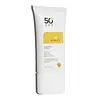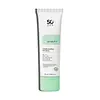What's inside
What's inside
 Key Ingredients
Key Ingredients

 Benefits
Benefits

 Concerns
Concerns

 Ingredients Side-by-side
Ingredients Side-by-side

Water
Skin ConditioningOctocrylene
UV AbsorberEthylhexyl Methoxycinnamate
UV AbsorberPEG-100 Stearate
Ceteareth-20
CleansingBis-Ethylhexyloxyphenol Methoxyphenyl Triazine
Skin ConditioningButyl Methoxydibenzoylmethane
UV AbsorberCaprylic/Capric Triglyceride
MaskingCetearyl Alcohol
EmollientMethylene Bis-Benzotriazolyl Tetramethylbutylphenol
UV FilterGlyceryl Stearate
EmollientCyclopentasiloxane
EmollientTitanium Dioxide
Cosmetic ColorantGlycerin
HumectantAcacia Seyal Gum Extract
HumectantDecyl Glucoside
CleansingEthylhexylglycerin
Skin ConditioningPhenoxyethanol
PreservativePropylene Glycol
HumectantDimethicone
EmollientAloe Barbadensis Leaf Extract
EmollientPanthenol
Skin ConditioningNiacinamide
SmoothingParfum
MaskingButylene Glycol
HumectantHydrolyzed Glycosaminoglycans
HumectantXanthan Gum
EmulsifyingEDTA
Sodium Hyaluronate Crosspolymer
HumectantSodium Hyaluronate
HumectantPropanediol
SolventAlpha-Arbutin
AntioxidantHyaluronic Acid
HumectantHydrolyzed Hyaluronic Acid
HumectantTheobroma Cacao Seed Extract
AntioxidantTocopheryl Acetate
AntioxidantGeraniol
PerfumingCitronellal
MaskingHexyl Cinnamal
PerfumingWater, Octocrylene, Ethylhexyl Methoxycinnamate, PEG-100 Stearate, Ceteareth-20, Bis-Ethylhexyloxyphenol Methoxyphenyl Triazine, Butyl Methoxydibenzoylmethane, Caprylic/Capric Triglyceride, Cetearyl Alcohol, Methylene Bis-Benzotriazolyl Tetramethylbutylphenol, Glyceryl Stearate, Cyclopentasiloxane, Titanium Dioxide, Glycerin, Acacia Seyal Gum Extract, Decyl Glucoside, Ethylhexylglycerin, Phenoxyethanol, Propylene Glycol, Dimethicone, Aloe Barbadensis Leaf Extract, Panthenol, Niacinamide, Parfum, Butylene Glycol, Hydrolyzed Glycosaminoglycans, Xanthan Gum, EDTA, Sodium Hyaluronate Crosspolymer, Sodium Hyaluronate, Propanediol, Alpha-Arbutin, Hyaluronic Acid, Hydrolyzed Hyaluronic Acid, Theobroma Cacao Seed Extract, Tocopheryl Acetate, Geraniol, Citronellal, Hexyl Cinnamal
Water
Skin ConditioningDibutyl Adipate
EmollientDiethylamino Hydroxybenzoyl Hexyl Benzoate
UV FilterPropanediol
SolventEthylhexyl Triazone
UV AbsorberGlycerin
HumectantNiacinamide
SmoothingCoco-Caprylate/Caprate
EmollientCaprylyl Methicone
Skin ConditioningMethylene Bis-Benzotriazolyl Tetramethylbutylphenol
UV FilterButylene Glycol
Humectant1,2-Hexanediol
Skin ConditioningPentylene Glycol
Skin ConditioningPhenoxyethanol
PreservativeLauryl Glucoside
CleansingPolyglyceryl-2 Dipolyhydroxystearate
Skin ConditioningPolymethylsilsesquioxane
Sodium Stearoyl Glutamate
CleansingMyristyl Alcohol
EmollientMyristyl Glucoside
CleansingCentella Asiatica Leaf Extract
Skin ConditioningZea Mays Starch
AbsorbentDecyl Glucoside
CleansingHdi/Trimethylol Hexyllactone Crosspolymer
Carbomer
Emulsion StabilisingPolyacrylate Crosspolymer-6
Emulsion StabilisingSodium Hydroxide
BufferingAcrylates/C10-30 Alkyl Acrylate Crosspolymer
Emulsion StabilisingSodium Hyaluronate Crosspolymer
HumectantSodium Hyaluronate
HumectantSodium Acetylated Hyaluronate
HumectantHydrolyzed Sodium Hyaluronate
Skin ConditioningAcacia Seyal Gum Extract
HumectantEthylhexylglycerin
Skin ConditioningPropylene Glycol
HumectantXanthan Gum
EmulsifyingCitric Acid
BufferingWater, Dibutyl Adipate, Diethylamino Hydroxybenzoyl Hexyl Benzoate, Propanediol, Ethylhexyl Triazone, Glycerin, Niacinamide, Coco-Caprylate/Caprate, Caprylyl Methicone, Methylene Bis-Benzotriazolyl Tetramethylbutylphenol, Butylene Glycol, 1,2-Hexanediol, Pentylene Glycol, Phenoxyethanol, Lauryl Glucoside, Polyglyceryl-2 Dipolyhydroxystearate, Polymethylsilsesquioxane, Sodium Stearoyl Glutamate, Myristyl Alcohol, Myristyl Glucoside, Centella Asiatica Leaf Extract, Zea Mays Starch, Decyl Glucoside, Hdi/Trimethylol Hexyllactone Crosspolymer, Carbomer, Polyacrylate Crosspolymer-6, Sodium Hydroxide, Acrylates/C10-30 Alkyl Acrylate Crosspolymer, Sodium Hyaluronate Crosspolymer, Sodium Hyaluronate, Sodium Acetylated Hyaluronate, Hydrolyzed Sodium Hyaluronate, Acacia Seyal Gum Extract, Ethylhexylglycerin, Propylene Glycol, Xanthan Gum, Citric Acid
Ingredients Explained
These ingredients are found in both products.
Ingredients higher up in an ingredient list are typically present in a larger amount.
We don't have a description for Acacia Seyal Gum Extract yet.
Butylene Glycol (or BG) is used within cosmetic products for a few different reasons:
Overall, Butylene Glycol is a safe and well-rounded ingredient that works well with other ingredients.
Though this ingredient works well with most skin types, some people with sensitive skin may experience a reaction such as allergic rashes, closed comedones, or itchiness.
Learn more about Butylene GlycolDecyl Glucoside is a glucose-based surfactant and emulsion stabilizer. It is created by reacting glucose with the fatty acids from plants.
Surfactants help clean the skin by trapping oil, sebum, and dirt to be washed away. As an emulsion stabilizer, it stabilizes the ingredients in a product by preventing them from separating.
This ingredient is biodegradable and non-toxic. This ingredient is commonly found in baby shampoos.
Decyl Glucoside is sometimes used to stabilize the UV filter Tinosorb.
Learn more about Decyl GlucosideEthylhexylglycerin (we can't pronounce this either) is commonly used as a preservative and skin softener. It is derived from glyceryl.
You might see Ethylhexylglycerin often paired with other preservatives such as phenoxyethanol. Ethylhexylglycerin has been found to increase the effectiveness of these other preservatives.
Glycerin is already naturally found in your skin. It helps moisturize and protect your skin.
A study from 2016 found glycerin to be more effective as a humectant than AHAs and hyaluronic acid.
As a humectant, it helps the skin stay hydrated by pulling moisture to your skin. The low molecular weight of glycerin allows it to pull moisture into the deeper layers of your skin.
Hydrated skin improves your skin barrier; Your skin barrier helps protect against irritants and bacteria.
Glycerin has also been found to have antimicrobial and antiviral properties. Due to these properties, glycerin is often used in wound and burn treatments.
In cosmetics, glycerin is usually derived from plants such as soybean or palm. However, it can also be sourced from animals, such as tallow or animal fat.
This ingredient is organic, colorless, odorless, and non-toxic.
Glycerin is the name for this ingredient in American English. British English uses Glycerol/Glycerine.
Learn more about GlycerinMethylene Bis-Benzotriazolyl Tetramethylbutylphenol (Tinosorb M) is a hybrid and broad-spectrum UV ingredient. It is both a UV absorber and filter.
UV absorbers are an agent that absorbs UV rays. They protect your skin by using chemical reactions to convert UV rays into heat and energy. UV filters physically reduce the amount of UV rays from reaching your skin.
Tinosorb M covers a range of 280-400 nm and is photostable. This ingredient is neither oil or water soluble.
Tinosorb M is not available in the US. However, it is available in the EU and Asia.
It's sister, Tinosorb S, is set to be approved in the US by late 2025 (fingers crossed!).
Learn more about Methylene Bis-Benzotriazolyl TetramethylbutylphenolNiacinamide is a multitasking form of vitamin B3 that strengthens the skin barrier, reduces pores and dark spots, regulates oil, and improves signs of aging.
And the best part? It's gentle and well-tolerated by most skin types, including sensitive and reactive skin.
You might have heard of "niacin flush", or the reddening of skin that causes itchiness. Niacinamide has not been found to cause this.
In very rare cases, some individuals may not be able to tolerate niacinamide at all or experience an allergic reaction to it.
If you are experiencing flaking, irritation, and dryness with this ingredient, be sure to double check all your products as this ingredient can be found in all categories of skincare.
When incorporating niacinamide into your routine, look out for concentration amounts. Typically, 5% niacinamide provides benefits such as fading dark spots. However, if you have sensitive skin, it is better to begin with a smaller concentration.
When you apply niacinamide to your skin, your body converts it into nicotinamide adenine dinucleotide (NAD). NAD is an essential coenzyme that is already found in your cells as "fuel" and powers countless biological processes.
In your skin, NAD helps repair cell damage, produce new healthy cells, support collagen production, strengthen the skin barrier, and fight environmental stressors (like UV and pollution).
Our natural NAD levels start to decline with age, leading to slower skin repair, visible aging, and a weaker skin barrier. By providing your skin niacinamide, you're recharging your skin's NAD levels. This leads to stronger, healthier, and younger looking skin.
Another name for vitamin B3 is nicotinamide. This vitamin is water-soluble and our bodies don't store it. We obtain Vitamin B3 from either food or skincare. Meat, fish, wheat, yeast, and leafy greens contain vitamin B3.
The type of niacinamide used in skincare is synthetically created.
Learn more about NiacinamidePhenoxyethanol is a preservative that has germicide, antimicrobial, and aromatic properties. Studies show that phenoxyethanol can prevent microbial growth. By itself, it has a scent that is similar to that of a rose.
It's often used in formulations along with Caprylyl Glycol to preserve the shelf life of products.
Propanediol is an all-star ingredient. It softens, hydrates, and smooths the skin.
It’s often used to:
Propanediol is not likely to cause sensitivity and considered safe to use. It is derived from corn or petroleum with a clear color and no scent.
Learn more about PropanediolPropylene Glycol is an odorless, colorless liquid. As a humectant, it helps skin retain moisture. It also aids in delivering active ingredients.
Another role of this ingredient is preventing a product from melting or freezing. Propylene glycol also adds antimicrobrial properties to a product, elongating product lifespan.
This ingredient is considered an organic alcohol and commonly added into both cosmetics and foods.
Those with sensitive skin or conditions may develop a rash when using this ingredient.
Learn more about Propylene GlycolSodium Hyaluronate is hyaluronic acid's salt form. It is commonly derived from the sodium salt of hyaluronic acid.
Like hyaluronic acid, it is great at holding water and acts as a humectant. This makes it a great skin hydrating ingredient.
Sodium Hyaluronate is naturally occurring in our bodies and is mostly found in eye fluid and joints.
These are some other common types of Hyaluronic Acid:
Learn more about Sodium HyaluronateSodium Hyaluronate Crosspolymer is a type of hyaluronic acid. In fact, it is modified version of hyaluronic acid.
The structure of Sodium Hyaluronate Crosspolymer allows it to stay in the skin's top layer for a longer period of time. This allows for even more hydration and humectant action than hyaluronic acid.
These are some other common types of Hyaluronic Acid:
Learn more about Sodium Hyaluronate CrosspolymerWater. It's the most common cosmetic ingredient of all. You'll usually see it at the top of ingredient lists, meaning that it makes up the largest part of the product.
So why is it so popular? Water most often acts as a solvent - this means that it helps dissolve other ingredients into the formulation.
You'll also recognize water as that liquid we all need to stay alive. If you see this, drink a glass of water. Stay hydrated!
Learn more about WaterXanthan gum is used as a stabilizer and thickener within cosmetic products. It helps give products a sticky, thick feeling - preventing them from being too runny.
On the technical side of things, xanthan gum is a polysaccharide - a combination consisting of multiple sugar molecules bonded together.
Xanthan gum is a pretty common and great ingredient. It is a natural, non-toxic, non-irritating ingredient that is also commonly used in food products.
Learn more about Xanthan Gum